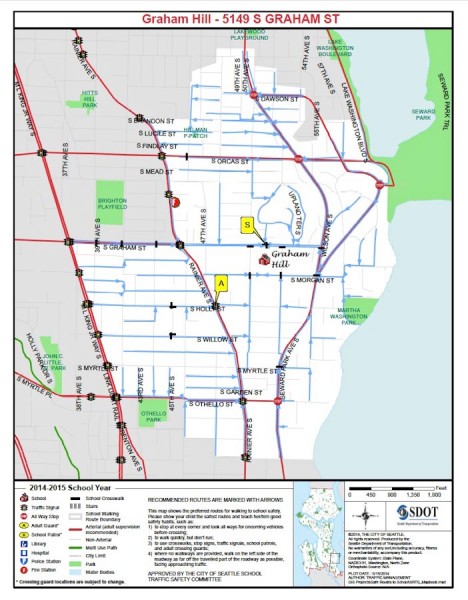
South Seattle elementary school students who were threatened by a gunman on their walk home from school last year won’t be allowed to ride the bus anymore, the Seattle School Board decided yesterday.
Back in September, a gunman attempted to lure a group of children walking home from Graham Hill Elementary into his car. Kristopher Green, a Student and Family Advocate at the southeast Seattle public school, had been walking the students home when the incident occurred. When Green confronted the man, he threatened to kill them.
Many of the students fled to safety, while the gunman backed up his car to stop one of them. Green shielded the student and rushed away, then the man opened fire on them.
No one was injured, and police were able to apprehend the gunman, later identified as Merhawi Tsehaye, with Green’s help.
Green’s heroic actions may have saved his students’ lives, but the incident prompted him to turn his spotlight on the larger issue of transit justice, and the way school district bus cuts have impacted students.
Last February, faced with a budget shortfall, the district implemented a new busing plan and cut bus service for about a thousand students. According to the school officials, this saved the district more than $2.9 million, but it also meant that many students who had been receiving SPS-funded transportation last school year were denied bus services this year.
This shift ignited community concerns that bus cuts disproportionally affected low-income, English Language Learner and special needs students. The route cuts were the reason those Graham Hill children were walking home on the day of the attempted kidnapping, instead of riding the bus.
“We found out that we have many families that live near the 7400 block of Rainier, and I volunteered to pick these students up in the morning and walk with them to school and home from school,” says Green.

Because the walk was over a mile long, and many of the young students got tired, so Green would sometimes pay for the Metro bus take them home.
After the September incident the Graham Hill administration and community demanded that the school district provide more transportation services. Although they have allowed seventeen students who were directly affected to board an existing bus route, they have not provided any additional buses, nor are they allowing other students who live on the same block to board the bus.
“Our most-impacted families are often our low-income families of color, who cannot take time off their jobs to walk their child to school,”says Walter Chen, Graham Hill Elementary School’s principal. “We should also be mindful of the neighborhoods in which we ask our families to walk to school. No kindergartener should have to walk a mile down Rainier Ave to get to school.”
“I believe the school district should be providing transportation to… all students who live in areas with higher rates of violent crime if they live further than .5 mile,” agrees Green, referring to the current district policy that sets a two mile walk zone for high school and middle school students and a one mile walk zone for elementary school students.
But facing multi-million dollar budget shortfalls, and pressing statewide mandates to raise standards and shrink class sizes, the district is backed into a corner.
At a school board meeting last night, the board voted unanimously to approve the Transportation Service Standards for 2015-2016. This will eliminate some bus service for low-income schools like Roxhill Elementary School and Concord Elementary School, as well as the walk-in zone spots on the Graham Hill 678 Route — the bus for the students who were directly affected by the shooting incident in September.
“This transportation standards package enables the whole district to move forward with its basic transportation plan,” said board director Marty McLaren. “However, we have the option of giving the superintendent the flexibility of making adjustments in this transportation plan, so the operations committee which oversees this will be looking carefully at the issues where parents are worried about safety and other challenges to getting their students to school.
Despite the approved standard changes, the board thanked the Graham Hill parents and advocates at the meeting for their public testimony against the changes and assured them that in the future, “the district is committed to looking at these issues through an equity lens.”
For his part, Green has urged families worried about their diminished options for getting their kids to school to let their voices be heard by writing emails and making phone calls to their school principals and school board officials.
“The goal of the district [is] to have students in school every day when healthy,” Green continued. “Cutting bussing services for families that you have provided this service for in the past is a move that, in my opinion, is in direct opposition that your stated goals for equity in education and student safety.”

